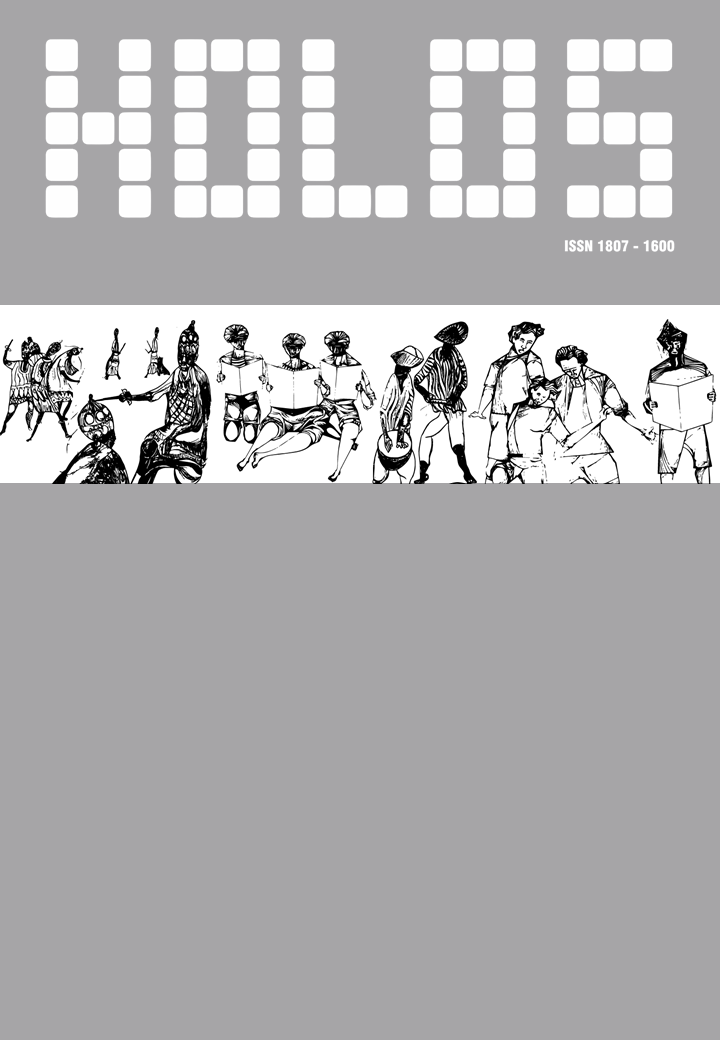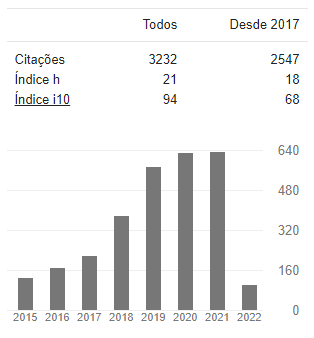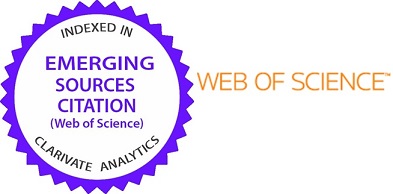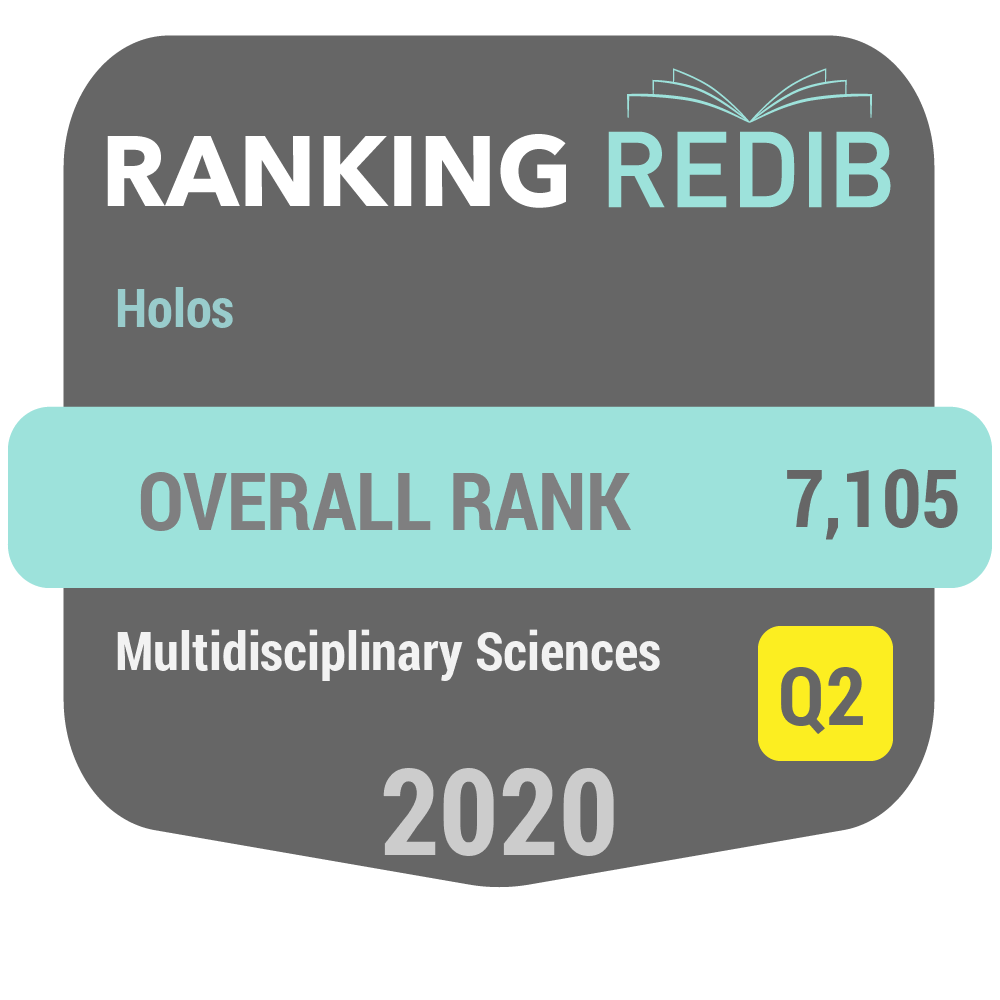RADIAÇÃO ULTRAVIOLETA, OZÔNIO TOTAL E AEROSSÓIS NA CIDADE DE NATAL-RN
DOI:
https://doi.org/10.15628/holos.2013.1839Resumo
A cidade de Natal é denominada pelos seus habitantes de “Cidade do Sol” em razão de sua elevada luminosidade, contudo a capital do Rio Grande do Norte possui taxas de câncer de pele não melanoma acima da média das capitais do Nordeste do Brasil. Neste cenário, o presente artigo apresenta um estudo da radiação ultravioleta (UV) e índice UV em Natal e suas relações com variáveis relevantes como ozônio total, aerossóis, radiação solar global (RSG) e nebulosidade. A metodologia realizou um estudo descritivo e estatístico com aplicação da Análise de Componentes Principais (ACP) e Gráfico Biplot. Os dados foram obtidos no Instituto Nacional de Pesquisas Espaciais/Centro Regional do Nordeste (INPE/CRN), nos instrumentos TOMS-OMI/AURA e MODIS/TERRA e no Instituto Nacional de Meteorologia do Brasil. Os resultados indicaram que o índice UV apresenta média anual igual a 11, classificado como extremo pela Organização Mundial de Saúde e a intensidade da UVB e índice UV no primeiro semestre do ano são mais intensos que no segundo. A variabilidade anual da UV possui uma característica nos meses de setembro e outubro que consiste em uma estabilização/redução do índice UV numa fase de crescimento da RSG em razão da maior concentração anual de ozônio total, sendo que a maior quantidade de aerossóis contribui em menor escala para este evento. A ACP e gráfico Biplot contribuíram para identificar o evento, pois indicaram que o ozônio total e aerossóis possuem uma forte correlação negativa com o índice UV nos referidos meses. Os autores chamaram esta característica de Evento Anual de Primavera da UV (EAP-UV), uma vez que ocorre no início e durante esta estação.Downloads
Referências
MADRONICH, S. UV radiation in the natural and perturbed atmosphere. In: Tevini, M (Ed). UV-B Radiation and Ozone Depletion. London: Lewis Publishers. p. 17-69, 1993.
LIOU, K. N. An Introduction to Atmospheric Radiation. Second Edition. Academic Press, USA, 2002.
WHO. Global Solar Indice UV: A Practical Guide. World Health Organization, World Meteorological Organization (WMO), United Nations Environment Program (UNEP), and International Commission on Non-Ionising Radiation Protection (ICNRP), 18 p. Geneva, 2002.
WMO. Scientific assessment of ozone depletion, 2010. World Meteorological Organization, Report No. 47. Geneva, 2011.
FIOLETOV, V. E., KERR, J. B., WARDLE, D. I. The relationship between total ozone and spectral UV irradiance from Brewer observations and its use for derivation of total ozone from UV measurements. Geophysical Research Letters, v.24, n. 23, p. 2997-3000, Canada, 1997.
FREDERICK, J. E., LUBIN, D. Solar Ultraviolet Irradiance at Palmer Station, Antarctica. Ultraviolet Radiation in Antarctica: Measurements and Biological Effects. Antarctic Research Series, v. 62, p. 43-52, 1994.
KIRCHHOFF, V. W. J. H. Ozônio e Radiação UV–B. Transtec Editorial, São José dos Campos, São Paulo, 1995.
SABBURG, J., WONG, J. The effect of clouds on enhancing UVB irradiance at the earth’s surface: a one year study. Geophysical Research Letters, 27, p. 3337-3340, 2000.
HORVÁTH, M., BILITZKY, L., HUTTNER, J. Ozone. New York: Elsevier. 350 p, 1985.
MCKENZIE, R.L. et al. Altitude effects on UV spectral irradiance deduced from measurements at Lauder, New Zealand, and at Mauna Loa Observatory, Hawaii. Journal of Geophysical Research, 106, p.22845-22860, 2001.
VANICEK, K. et al. UV Indice for the Public. COST-713 Action. Luxemburgo: Office for official publications of the European Communities, 50, 2000.
JACOBSON, Mark Z. Fundamentals of atmospheric modeling. Cambridge University Press, 2005.
SEINFELD, J. H. Atmospheric chemistry and physics of air pollution. New York: John Wiley and Sons, 760p, 1985.
YAMASOE, M. A., Artaxo, P., Schafer, J., Eck, T. e Holben, B. Measurements and calculations of the influence of smoke particles on photosynthetically active radiation fluxes reaching the surface in the Amazon. Eos Trans. AGU, 81 (48), Fall Meet. Suppl., Abstract B61E-07, 2000.
HERMAN, J.R et al. Changes in cloud and aerosol cover (1980–2006) from reflectivity time series using SeaWiFS, N7-TWHO, EP-TWHO, SBUV-2, and OMI radiance data. Journal of Geophysical Research, vol. 114, p. 01-21, 2009.
CASICCIA, C., ZAMORANO, F. Erythemal irradiance at the Magellan’s region and Antarctic ozone hole 1999-2005. Atmósfera, 21(1), 1-12, 2008.
FAHEY, D.W., HEGGLIN M.I. (Coordinating Lead Authors). Twenty Questions and Answers about the Ozone Layer: 2010 Update, Scientific Assessment of Ozone Depletion: 2010, 72 pp., World Meteorological Organization, Geneva, Switzerland, 2011.
HEGGLIN, M. I. SHEPHERD T. G. Large climate-induced changes in ultraviolet index and stratosphere-to-troposphere ozone flux. Nature Geoscience 2, p. 687-691, set, 2009.
CORDERO, E. et al. Stratospheric Dynamics and the Transport of Ozone and Other Trace Gases. In: Chapter 6-Stratospheric Ozone: An Electronic Textbook, 2012 [Internet]. Disponível em: http://www.ccpo.odu.edu/~lizsmith/SEES/ozone/oz_class.htm
SAHAI, Y., KIRCHHOFF, V., LEME, N. M. Total ozone trends in the tropics. Journal of Geophysical Research, v.105, n.D15, p. 19823-19823. EUA, 2000.
MCKENZIE et al. Ozone depletion and climate change: impacts on UV radiation. Photochem. Photobiol. Sci., 10, 182-198, 2011.
MCKENZIE, R.L. et al. Changes in biologically active ultraviolet radiation reaching the Earth’s surface. Photochem Photobiol. Sci., v. 2, p. 1-4, 2003.
HERMAN J.R. Global increase in UV irradiance during the past 30 years (1979–2008) estimated from satellite data. Journal of Geophysical Research, vol. 115, p. 01-15, 2010.
LEE-TAYLOR, J., MADRONICH, S. Climatology of UV-A, UV-B, and Erythemal Radiation at the Earth's Surface, 1979-2000, National Center for Atmospheric Research Boulder, Colorado, 2007.
INMET. Normais Climatológicas do Brasil 1961-1990. Brasília, DF, 2009.
FURTADO, Edna Maria. A onda do turismo na cidade do sol: a reconfiguração urbana de Natal, 2005.
INCA-Instituto Nacional de Câncer José Alencar Gomes da Silva, 2011. Estimativa 2012-Incidência de Câncer no Brasil. Ministério da Saúde do Brasil.
WEBB A.R., Holick, M. F. The role of sunlight in the cutaneous production of vitamin D3. Annu. Rev. Nutr., 8, p. 375-99, 1988.
PARISI, A.F., GREEN, A., KIMLIN, M.G. Diffuse solar ultraviolet irradiation and implications for preventing human eye damage. Photochem. Photobiol., v. 73, n. 2, p. 135-139, 2001.
DE GRUIJL, F. R. UV-induced immunosuppression in the balance. Photochem. Photobiol. 84, p. 2–9, 2008.
MADRONICH, S., GRUJIL, F.R. Skin cancer and UV radiation. Nature, 366, p. 23-28, 1993.
DIFFEY, B.L. The consistency of studies of ultraviolet erythema in normal human skin. Physics in Medicine and Biology, 27, p. 715-720, 1982.
DIFFEY, B.L. Solar ultraviolet radiation effects on biological systems. Physics in Medicine and Biology, 36(3), p. 299-328, 1991.
LONGSTRETH, J. et al. Health risks. J.Photoch. Photobio. B,v. 46, p. 20-39, 1998.
CORRÊA, M. P. Índice ultravioleta: avaliações e aplicações. Tese (Doutorado Ciências-meteorologia) Instituto de Astronomia, Geofísica e Ciências Atmosféricas, USP, São Paulo, 2003.
ARAÚJO, V. M. D., 1996. Parâmetros de conforto térmico para usuários de edificações escolares no litoral nordestino brasileiro. Tese de doutorado. FAUSP. São Paulo.
PEREIRA, E. B. et al. Atlas brasileiro de energia solar, INPE, São José dos Campos, Brasil. ISBN 978-85-17-00030-0, 2006.
IBGE. Mapa de Clima do Brasil. [Internet], 2013. Disponível em ftp://geoftp.ibge.gov.br/mapas_tematicos/mapas_murais/. Acesso: Novembro-2013
NEVES, J.A. Um índice de susceptibilidade ao fenômeno da seca para o semiárido nordestino. Tese de Doutorado, Universidade Federal de Pernambuco, UFPE, Recife, 2010.
NOBRE, P., MELO, A. B. C. Variabilidade climática intrasazonal sobre o Nordeste do Brasil em 1998-2000. Revista Climanálise, ano 2, n.1, 2004.
LOPO, A. B., MATA, M. V. M., ANDRADE, R. L., SILVA, C. M. S. Ciclo diário de precipitação sobre a cidade de Natal-RN. Congresso Brasileiro de Meteorologia, SBMET, Belém, Brasil, 2010.
MOTTA, Adauto Gouveia. O clima de Natal. Natal: Foco,[s/d], 2004.
NOBRE, C. A., MOLION, L. C. B. The climatology of drought and drought prediction. In: PARRY, T. R.; CARTER, R.; KONJIN, N. T. The impact of variations on agriculture. Volume 2: Assessments in Semi-arid Regions. Dordrech: Kluwer, p. 305-323, 1988.
IBGE. Estimativa Populacional 2013, [Internet], 2013. Disponível em: ftp://ftp.ibge.gov.br/Estimativas_de_Populacao/Estimativas_2013/estimativa_2013_dou.pdf
MCKINLAY, A., F. DIFFEY, B. L. A reference action spectrum for ultraviolet-induced erythema in human skin. In: Passchler and Bosnajokovic ed. Human exposure to ultraviolet radiation: Risks and regulations. Amsterdã, Elsevier, 1987.
Biospherical Instruments. Application note: GUV “Diffey Dose” calculations. URL<http://www.biospherical.com>.
GES DISC-Database of NASA-Goddard Earth Sciences Data and Information Services Center [Internet]. EUA, 2013. Disponível em: http://avdc.gsfc.nasa.gov/
LEPTOUKH, G. et al. NASA GES DISC on-line visualization and analysis system for gridded remote sensing data. In: Leptoukh, S. Berrick, H. Rui, Z. Liu, T. Zhu, S. Shen//Proc. of the 31th International Symposium of Remote Sensing of the Environment, 2005.
SMITH, Jacqueline (Ed.). The Facts on File dictionary of weather and climate. Infobase Publishing, 2009.
INPE/CRN/LAVAT-Instituto Nacional de Pesquisas Espaciais/Centro Regional do Nordeste. Laboratório de Variáveis Ambientais Tropicais. [Internet]. BRASIL, 2013. Disponível em: http:// http://www.crn2.inpe.br/lavat/
INMET/BDMEP. [Internet]. BRASIL, 2013. Disponível em: http://www.inmet.gov.br/projetos/rede/pesquisa/.
INPE/CPTEC/SISAM, 2013. [Internet]. BRASIL, 2013. Disponível em: http://sisam.cptec.inpe.br.
JOHNSON, R. A., WICHERN, D., W. Applied Multivariate Statistical Analysis, Fifth Edition, cp. 1 – Aspects of Multivariate Analysis, cp. 2 – Matrix Algebra and Random Vectors, cp. 8 – Principal Components, 2002.
MINGOTI, S. A. Análise de dados através de Métodos de Estatística Multivariados. UFMG, 2005.
WILKS, S. D. Statistical Methods in the Atmospheric Sciences. Academic Press,
San Diego, 2ª ed, 2006.
R Development Core Team. R: A language and environment for statistical computing. R Foundation for Statistical Computing, 2002. Vienna, Austria. ISBN 3-900051-07-0. [Internet]. Austria, 2013. Disponível em: http://www.r-project.org/
GABRIEL, K. R. The biplot graphic display of matrices with application to principal component analysis. Biometrika, Oxford, v.58, nº 3, p. 453-467, 1971.
MARÍN FERNÁNDEZ, María José et al. Estudio de la irradiancia solar ultravioleta B y eritemática en la Comunidad Valenciana. 2007.
SILVA, F. R. Estudo da Radiação Ultravioleta na cidade de Natal-RN. Dissertação (Mestrado Engenharia Mecânica) - UFRN, Natal-RN, 2008.
VAREJÃO, M. A. Meteorologia e Climatologia. Versão digital nº 02, Recife, 2006.
ROY, C. R., GIES, H. P., TOOMEY, S. Monitoring UV-B at the earth’s surface. Australian Meteorological Magazine, v. 46, nº 3, p. 203-210, 1997.
CORRÊA, M.P., DUBUISSON, P., PLANA-FATTORI, A. An Overview of the Ultraviolet Index and the Skin Cancer Cases in Brazil. Photochemistry and Photobiology, 78(1): p. 49–54, 2003.
IALONGO, I. Comparison of total ozone and erythemal UV data from OMI with ground-based measurements at Rome station. Atmos. Chem. Phys., 8, p. 3283–3289, 2008.
KIRCHHOFF, V. W. J. H et al. Equatorial ozone characteristics as measured at Natal (5.9°S, 35.2°W). Journal of Geophysical Research. Volume 88, Issue C11, p. 6812–6818, 1983.
OLIVEIRA, H. S. M., SILVA, F. R., MARÍTIMO, G., LEME, N. M. P. Análise da coluna de ozônio em Natal-RN. II Simpósio Brasileiro de Geofísica Espacial e Astronomia, UFCG, Brasil, 2008.
CORRÊA, M.P., CEBALLOS, J. C., PLANA-FATTORI, A. Uma análise das variações do Índice Ultravioleta em relação às observações de conteúdo de ozônio e da espessura óptica dos aerossóis sobre a cidade de São Paulo. Revista Brasileira de Meteorologia, v.21, nº 1, p. 24-32, São Paulo, 2006.
CORRÊA, M.P., CEBALLOS, J. C. Solar Ultraviolet Radiation Measurements in One of the Most Populous Cities of the World: Aspects Related to Skin Cancer Cases and Vitamin D Availability. Photochemistry and Photobiology, V. 86, p. 438–444, 2010.
SILVA, A. A. A Espessura óptica de aerossóis na banda do UV-B. Tese de Doutorado em Geofísica Espacial-INPE, São Jose dos Campos, 2002.









































